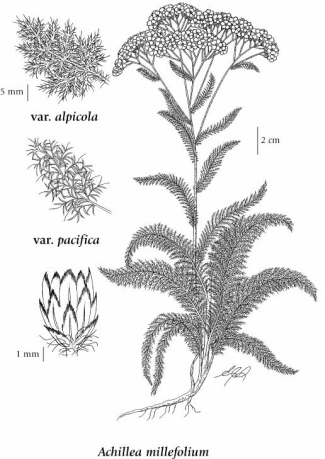yarrow (common yarrow)
Asteraceae (Aster family)
Introduction to Vascular Plants
Species Information click to expand contents
General:
Perennial, aromatic herb, usually rhizomatous; stems erect, slender, 10-100 cm tall.
Leaves:
Fernlike, alternate, stalked below and unstalked above, pinnately dissected, the divisions again dissected.
Flowers:
Heads numerous, in a short, flat or round-topped cluster; involucral bracts dry, overlapping in several series, often dark-margined; ray flowers usually 3-8, 2-3.5 mm long, white to sometimes pink or reddish; disk flowers 15-40, cream colored.
Fruits:
Achenes glabrous, flattened, 1-2 mm long; pappus lacking.
Notes:
Taxonomically, one of our most complex species. Tyrl (1980) presented a sound case for recognizing only a single variable species. I, however, have recognized four, broad ecogeographical forms (sensu Nobs 1960) at the varietal level since these forms are ecologically significant in BC.
1. Leaves grey, long-hairy to woolly; plants usually in and east of the Coast-Cascade Mountains.
2. Involucral bract margins light brown to black; stems usually less than 30 cm tall; plants of the subalpine and alpine zones................. var. alpicola (Rydb.) Garrett
2. Involucral bract margins light brown to straw-coloured; stems usually more than 30 cm tall; plants of the montane and steppe zones........................ var. lanulosa (Nutt.) Piper in Piper & Beattie
1. Leaves usually green, moderately long-hairy; plants of coastal regions.
3. Involucral bract margins dark brown to black; stems 10-40 cm tall........................ var. borealis (Bong.) Farwell
3. Involucral bract margins hyaline to light straw-coloured; stems 30-100 cm tall.................. var. pacifica (Rydb.) G.N. Jones
Illustration click to expand contents

If more than one illustration is available for a species (e.g., separate illustrations were provided for two subspecies) then links to the separate images will be provided below. Note that individual subspecies or varietal illustrations are not always available.
Illustration Source: The Illustrated Flora of British Columbia
USDA Species Characteristics click to expand contents
Flower Colour:
White
Blooming Period:
Early Summer
Fruit/Seed characteristics:
Colour: Brown
Present over the Summer
Source: The USDA
Ecology click to expand contents
The table below shows the species-specific information calculated from
original data (BEC database) provided by the BC Ministry of Forests and Range.
(Updated August, 2013)
| Site Information |
Value / Class |
||
|
Avg |
Min |
Max |
|
| Elevation
(metres) |
1143 | 0 | 2854 |
| Slope
Gradient (%) |
24 | 0 | 360 |
|
Aspect (degrees) |
189 | 0 | 360 |
| Soil
Moisture Regime (SMR) [0 - very xeric; 4 - mesic; 8 - hydric] |
3 | 0 | 8 |
| Modal
Nutrient Regime
Class |
C | ||
| #
of field plots species was recorded in: |
8643 | ||
| Modal
BEC Zone Class |
IDF | ||
|
All BEC Zones (# of stations/zone) species was recorded in |
AT(124), BAFA(34), BG(471), BWBS(468), CDF(63), CMA(4), CWH(110), ESSF(1352), ICH(346), IDF(2274), IMA(24), MH(18), MS(822), PP(577), SBPS(448), SBS(848), SWB(178) | ||
|
Source:
Klinkenberg 2013
|
|||
Habitat and Range click to expand contents
Status Information click to expand contents
Synonyms click to expand contents
Synonyms and Alternate Names:
Achillea magna auct.
Taxonomic Keys click to expand contents
Two species of Achillea in BC may be confused: Achillea millefolium and A. sibirica. The third species, A. ptarmica, is distinctive, with few, larger flowerheads.
Key to A. millefolium and A. sibirica: 1. Leaves pinnately dissected, the divisions again dissected; plants widespread in BC......................A. millefolium 1. Leaves incised, the divisions of the latter merely toothed; plants of northeastern BC.......................A. sibirica Source: Illustrated Flora of British Columbia |
Taxonomic Notes click to expand contents
This species has been observed flowering in the Fraser Delta in December.
|